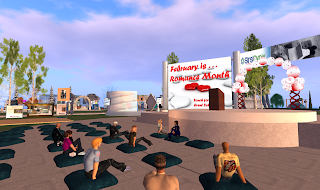The session began at the open air auditorium on Info Island (http://slurl.com/secondlife/Info%20Island/116/126/33) with a discussion on how to evaluate an institution's presence-building efforts in-world. Maxito started the discussion by explaining that many educational institutions, "are testing the waters to see if SL is another good way to pursue their overall mission...teaching, research service, etc.". Currently Maxito perceives institutions to be constructing spaces in SL. These virtual spaces are being used to hold events such as classes, lectures, symposia, social events and handle resources (create, collect, organize and distribute). He believes institutions hope their students (avatars) feel like they are part of the campus environment by trying to "recreate that campus feel." One of the benefits of the SL build space, Maxito explained, "it's much easier and cheaper in SL to build and reconfigure the built space to meet changing needs."
It was expressed that there is something about 3D virtual spaces that are very attractive to humans, however it takes collective efforts and time to understand new technologies. An interesting example of this was the development of the U of S interstate highway system. It was originally sold to officials as an instrument of national security. Troops needed to be able to move quickly in the event of a Soviet invasion. The interstate was not foreseen to assist in changing the entire urban landscape, creating a southwest population drift and changing the way people eat. With these types of unknown outcomes, Maxito believes, "one of the august responsibilities of any institution becoming active in SL is that they almost need to think about everything, from soup to nuts." Therefore when beginning to assess institutional presence-building in SL it is important to understand the focus of the effort. Is it to explore new ways of teaching and learning? Alternative ways to deliver distributed and distance education? Can it be used to attract prospective students or connect with alumni?
When it comes to assessment there are many things, in SL, that could be evaluated including buildings, grounds, teaching and learning tools, services, events, etc.. Maxito expressed, "I think that assessment here could be more important and useful than assessment in the real world." This is partly due to the fact that it is easier to make changes in SL but also, he believes, "the power to improve is much deeper in SL than in the real world." The ability to have decision-making power and implement change is a strong motivator for many individuals in SL. In RL there may be many factors (laws, bureaucracy, cost, etc.) that prevent an individual from being able to quickly implement desired change to their enviroment. Maxito believes this to be an advantage in SL, "Lots of people can move buildings on this island, for instance. Not many people have the decision-making power, technology, etc. in the real world to do that."
Three distinctions, Maxito mentioned, from real world assessment that may be useful in SL are provided by the 3-U's:
- Usability
- Use
- Usefulness
Maxito identified further distinctions to be valid in SL between behaviour, attitudes and opinions. When evaluating behaviour we may look at where avatars go, what they do, what they touch and use. In evaluating attitudes and opinions we can begin to look into avatar's beliefs, what they are saying and how they may be feeling.
The group was presented with some evaluation methodologies currently being used in SL. Many of the methodologies used in RL to analyze and collect research data are currently being used in SL including surveys, focus groups and interviews.
Surveys in SL are a useful, convenient method to collect research data. However, as in RL, it is difficult to get individuals to complete surveys and in some instances the responses may be heavily weighted towards specific sub-groups . One of the benefits in creating surveys in SL is the creativity that can be designed into the survey. In a virtual world surveys can look much different than in RL. For example on Health InfoIsland, a survey was designed as a series of avatar-sized panels.
Focus groups and individual interviews can also be conducted in SL. Maxito believes these data collection methods work well because, "People tend to be very open and thoughtful here in SL."
A tool, in SL, that may be used to collect behvioural data on a parcel of land is a "proximity sensor." These tools allow 24/7 monitoring and analysis of raw traffic counts, avatar names, time spent in specific locations, objects touched, etc.. A couple of companies offering these products can be located at rabbitstats.com and www.mayarealities.com.
We teleported to Karuna, a grant funded island dedicated to AIDS awareness, to see some examples of proximity sensors. The sensors we saw were distributed around the island to assist in collecting data to evaluate their presence building efforts. Although the sensors are deployed around the island, the controls are placed in one location so the data can easily be harvested.
 Proximity Sensor control cones (photo taken February 22/09)
Proximity Sensor control cones (photo taken February 22/09)The sensors used on Karuna Island are from Thomas Conover Products. Basic sensors are free of charge but ones more advanced can be purchased. Maxito explained that he finds these sensors easy to deploy, manage and harvest. Another aspect he found beneficial about these sensors is they can be set up so they don't cross parcel lines. If a sensor is placed near a location in a corner of a land parcel, it can be setup not to report on activity on the adjoining parcels. The reports produced for these specific sensors provided stats on number of avatars and how long they stayed on average.














